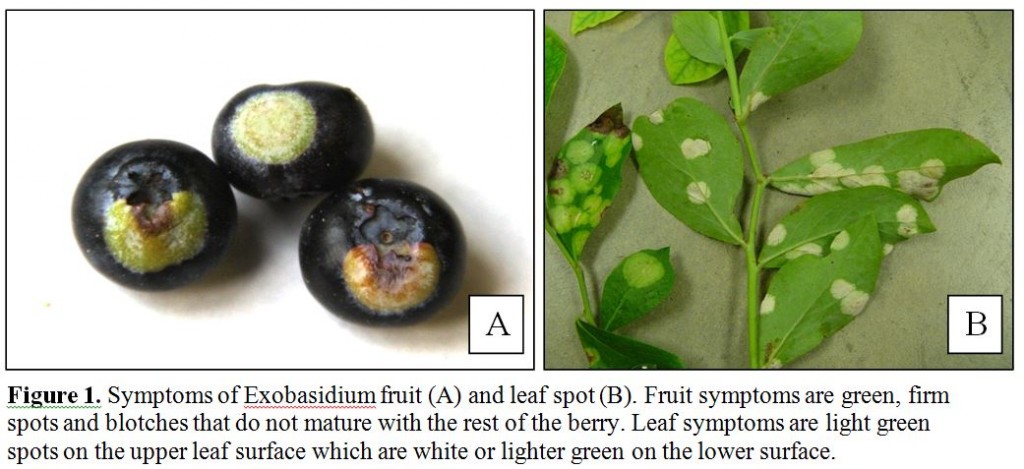Exobasidium fruit and leaf spot, caused by the fungus Exobasidium maculosum, is an emerging disease affecting both southern highbush and rabbiteye blueberries. Fruit symptoms include circular lesions which may be sunken and tinged with red color, diseased fruit tissue which is generally green and unripe, and sparse white fungal growth on spots. Leaf spots are light green on the upper side of the leaf and white on the underside, due to a thin layer of fungal growth (Fig. 1); leaf spots become necrotic (dried and brown) with age. Fruit lesions compromise the aesthetic qualities of the fruit, as well as the taste, rendering berries unmarketable. As a result, packing lines have to slow down to allow human sorters time to remove fruit with lesions, thereby increasing production costs. Even with this added effort, affected fruit are still able to make it into the package – increasing customer complaints.
In 2014, fungicides were evaluated for control of Exobasidium on the rabbiteye cultivar ‘Premier’ in the south Georgia counties of Appling, Bacon (3 locations), Clinch, Irwin, and Jeff Davis. Treatments included lime sulfur (5 gal/A), Sulforix (2 gal/A) or Captan 4L (2.5 qt/A; Bacon County locations only) applied at a late-dormant phenology (plant growth stage) with an airblast sprayer (~70 gallons/A total solution); no additional fungicides were applied. At least four replications of each treatment and the untreated control were applied to a randomized complete block design, with each plot consisting of ten plants; the outer two plants in each plot were considered to be buffers and were not utilized for treatment evaluation. All cultural practices were in keeping with rabbiteye blueberry production methods commonly observed in the Southeast. Leaf disease incidence was recorded from 13 May to 16 May with ~ 200 leaves per plot. Mature fruit were collected from 30 May to 10 June, and disease incidence was assessed on ~300 fruit per plot.
Rainfall was more than adequate for disease development, with an average of 15% of the leaves and 16% of the fruit showing symptoms in the untreated control. The single late-dormant application of either lime sulfur or Sulforix provided substantial and statistically equivalent management of Exobasidium, whereas Captan was not effective. The epidemiology of E. maculosum has not been elucidated, but the high level of disease control afforded with both Sulforix and lime sulfur may indicate that overwintering inoculum and/or early-season infections are of primary importance to disease development. The difference in efficacy between lime sulfur and Sulforix was diminutive, but Sulforix consistently outperformed lime sulfur with the exception of fruit spot incidence in Clinch County.
Based on the results obtained this year, we recommend that Sulforix be utilized for a late-dormant application as a component in a comprehensive management program for suppression of Exobasidium. Lime sulfur is still the product of choice for organic production, since Sulforix is not an organic product. As a result of this successful research project, we expect yields/pack-out to increase and consumer complaints to decrease in 2015. We will discuss a full-management program for Exobasidium in the winter blueberry meetings. In the interim, please contact your local county agent if you have pressing questions relative management of this disease.

Table 1. Exobasidium leaf and fruit spot incidence following treatment with lime sulfur, Sulforix or Captan.
| Leaf spot incidencey | ||||||||
| Treatment and rate/Az | Appling County | Bacon County Site 1 | Bacon County Site 2 | Bacon County Site 3 | Clinch County | Irwin County | Jeff Davis County | |
| Untreated control | 2.6 a | 25.0 a | 20.7 a | 9.7 a | 16.0 a | 20.1 a | 5.7 a | |
| Lime Sulfur (5 gal) | 0.7 ab | 4.1 b | 4.2 b | 2.5 b | 0.9 b | 2.2 b | 0.2 b | |
| Sulforix (2 gal) | 0.4 b | 3.3 b | 4.0 b | 2.1 b | 0.5 b | 1.6 b | 0.1 b | |
| Captan 4L (2.5 qt) | N/A | 27.42 a | 16.52 a | 6.62 a | N/A | N/A | N/A | |
| LSD (α=0.05) | 1.9 | 5.7 | 4.2 | 3.6 | 9.3 | 13.5 | 2.5 | |
| Fruit spot incidencex | ||||||||
| Treatment and Rate/A | Appling County | Bacon County Site 1 | Bacon County Site 2 | Bacon County Site 3 | Clinch County | Irwin County | Jeff Davis County | |
| Untreated Control | 2.3 a | 14.3 a | 15.4 a | 13.3 a | 8.1 a | 27.3 a | 31.8 a | |
| Lime Sulfur (5 gal) | 1.6 a | 1.6 b | 2.1 b | 1.8 c | 0.5 b | 3.0 b | 0.5 b | |
| Sulforix (2 gal) | 1.3 a | 1.0 b | 1.1 b | 0.7 c | 0.7 b | 2.1 b | 0.3 b | |
| Captan 4L (2.5 qt) | N/A | 13.8 a | 13.4 a | 7.2 b | N/A | N/A | N/A | |
| LSD (α=0.05) | 1.5 | 4.0 | 5.0 | 3.2 | 2.5 | 7.4 | 14.3 | |
zTreatments were single late-dormant applications between Jan 17 and Feb 15, depending on location.
yRecorded for 20 shoots per plot with ~10 leaves per shoot on average. Means followed by the same letter are not significantly different when using Fisher’s protected LSD test (P≤0.05).
xRecorded for ~300 fruit per plot on average. Means followed by the same letter are not significantly different when using Fisher’s protected LSD test (P≤0.05).